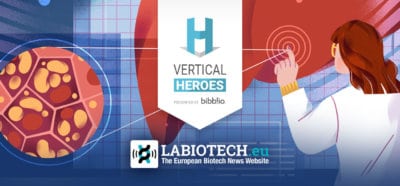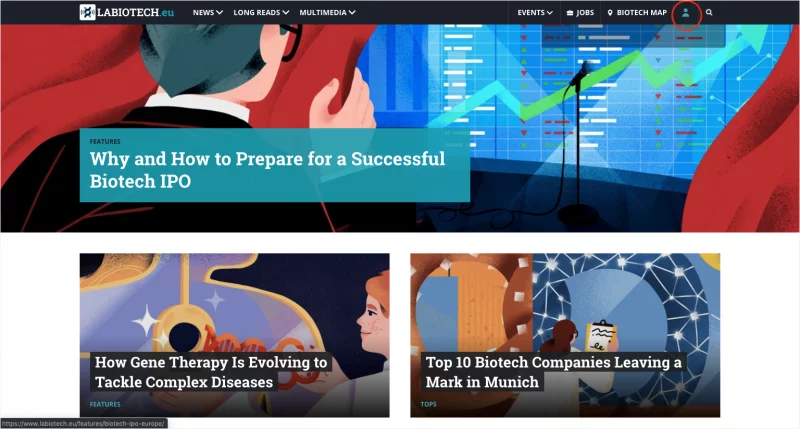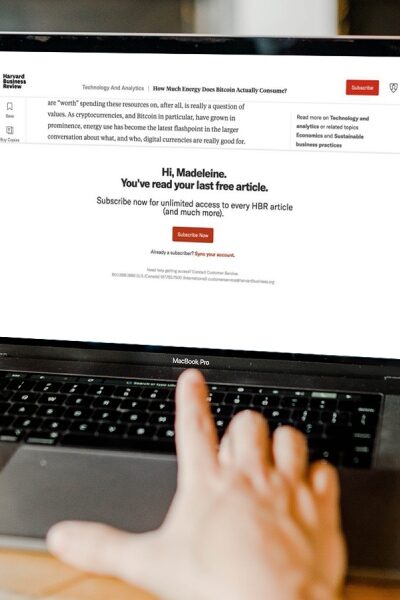With so much negative coverage of news publishing, we at Bibblio wanted to shine a spotlight on the many vertical publishers that are thriving. So we created an interview series called “Vertical Heroes”.
In this fifth edition, Labiotech.eu‘s founder & managing director Joachim Eeckhout discusses his Berlin-based media platform covering business and innovations in biotechnology. Bibblio CEO Mads Holmen had a chat with Joachim about the impact of page speed, branded content as route to success and their recently launched membership offer.
Mads: who is labiotech.Eu’s target audience?
Joachim: We’re targeting all professionals in the biotechnology industry. Our content focuses on European biotech but attracts professionals from all over the world. Some of our content also attracts more general audiences who are looking for information about new technologies in biotech.
M: what different types of content are you offering the biotech pros?
J: We divide our content into two main categories: news and long reads. Our news is published daily and covers what’s going on in the industry on a day-to-day basis. Our long reads include more in-depth articles such as technology reviews, top lists, interviews, and opinion pieces. As a ‘third type’ of content, we also have videos we publish through our YouTube channel.
M: how large is labiotech.Eu in terms of audience and staff?
J: We have over 150,000 monthly users which make our publication the largest in Europe for this topic. Labiotech.eu currently has eleven staff members, divided between editorial, growth and business development teams. Our team is very international. Across eleven people we have nine different nationalities! Berlin is a great spot to attract international talent and develop connections with the biotech and media industries.
M: what has been the secret sauce to grow into the leading publication for biotech?
J: Great quality content! We, as founders, weren’t trained journalists so we had to learn what it means to create quality content. Over the years and thanks to the team we recruited, our content increased a lot in quality to reach a level credible enough for a professional audience. But at the same time, we didn’t lose our identity and kept a casual tone in our articles, making it very distinct from the competition. We’re now recognised as a trusted source of information, often at the forefront of what’s published in Europe.

M: how do you prioritise attracting new audience vs. Engaging existing users deeper?
J: Our priority is to engage our existing audience. We have had constant growth since we started but we never tried to reach millions of people because we know that in the end, our audience is quite niche. To attract a broader audience would mean that we would have to change our focus to more general science and this is not what we want as a media. So our strategy is to focus on making people come back to our website and consume more of our content.
M: how are you retaining your audience?
J: We use our newsletter and social media channels (mainly LinkedIn) to engage our readers and drive them back to our site. Our newsletter especially has been a great success in the community and many people use it as their only source of information on the European market. We chose to send it only once a week while many competitors are sending daily updates. The result is that their opening and click rate are quite low compared to ours. When we send an email, our readers are usually keen to open it and discover what we’ve been publishing during the week.
M: what’s the key audience metrics you define success by?
J: We’re using a mix of different metrics to measure our success. We have the usual page views to measure our volume of traffic but we also look closely at quality metrics. We developed a custom metric we call “readers vs. scanners” which gives us a ratio between users reading our articles in depth vs. the one scanning it quickly. This has been a great insight into our content and helps us to understand better how our content is read.
M: define what seo means to you these days?
J: SEO is our first acquisition channel in terms of traffic but not the one we prioritize on in the long term. The traffic coming from Google is voluminous but we find it harder to convert this traffic into recurring users. The reason is that we rank very high on Google for very generic terms such as “HIV cure” or “cancer cure” but the traffic on these keywords is not specialized, so the visitors come once to get an answer to their questions but mostly will not come back.
Where SEO is interesting for us is for the more specialized requests, targeting company names or key people in the industry, for example. These keywords work well for us but of course, generate less volume of traffic.
We’ve also focused a lot on page speed lately as we’ve seen a great improvement in our ranking when our website loads quicker. We decided to redevelop our website from scratch at the end of 2018 with a focus on reducing the load time. The result was that we cut the loading time by half!
M: what’s your social media strategy, and how important is it for you to be present on those platforms? What’s the newest trend you’re seeing?
J: We always used a mix of LinkedIn, Twitter and Facebook. Our most successful channel has always been LinkedIn, as it is focused on professionals and fits very well with our content.
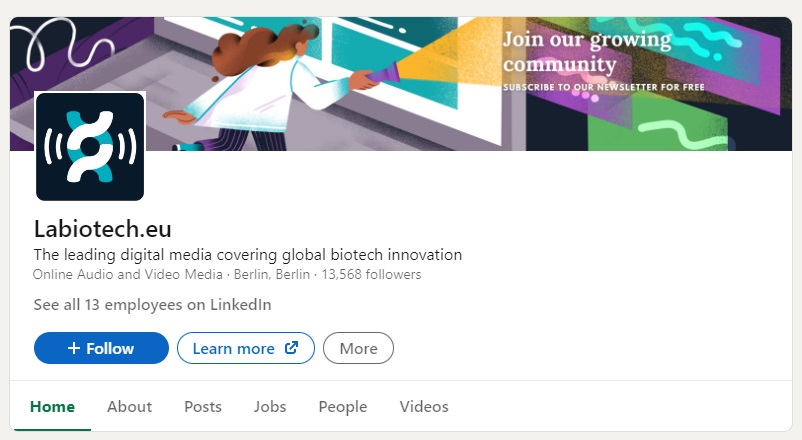
And lastly, with Facebook we always had to adapt to more casual information. We have good engagement, especially with a younger audience like students but we can’t share every type of article otherwise our engagement rate drops. Since Facebook also decided to focus more of its feed on what your close network is sharing, it’s getting harder for us as a publisher to reach a large audience.
We also tried other channels such as Instagram and Reddit with mixed results. We decided to not focus on them at the moment. As a B2B publication, it’s also harder to engage people on “entertainment” platforms such as Instagram, so the choice to not follow the trend was quite easy.
M: do you work together with other publications who write for the biotech industry?
J: Not directly. We’re in close and friendly contact with most of the competitors but we don’t have running partnerships with them. On the other hand, we partner a lot with event organisers in our vertical. It’s a great way for us to create and offline presence and interact with our community.
M: would you describe your business as data-driven?
J: We’ve always been focused on data, especially when it comes to taking decisions regarding our content, users and acquisition strategy. But data is limited in comparison to qualitative feedback so we try to listen as much as possible to what our readers have to say.
Sometimes it’s also gut-feeling! We are the first users of our platform so we also know what would make sense as a user without having to look too much into the data. The data is helpful to back up your idea and feel confident in launching new features or projects.
M: could you shed a bit of light on labiotech.Eu’s revenue models?
J: We’ve been focusing on advertising from day one. For us, it was the quickest way to generate revenue and create bonds with the key players in the industry. However, we always focused on not having intrusive advertising. For example, we don’t use as much display advertising as we could and we prefer to focus on branded content, which is better integrated on the website. We don’t allow more than 20% of our content to be branded and it seems that this is accepted very well by our audience. It’s been one of our key differentiators in the industry – other publications were not offering modern branded content when we started and this was key to our success.
We also ventured into the event business but discovered how hard it is to scale events successfully. In the end, we had to choose between investing most of our resources into growing events or keeping the focus on the media. We chose the media!
In May 2019, we decided to launch a membership offer to diversify our revenues and be less dependent on advertising. It’s quite early to say if this will be successful but we have very promising traction and feedback so far. Our goal is to make as much revenue from membership as we do from advertising.
Content from our partners
M: could you tell us more about your membership model?
J: The publishing industry seemed to switch massively to subscription models after the success of big publishers such as The New York Times. In B2B, the subscription model is just starting to emerge and we think that we can offer a very attractive product to our members without having to put a paywall on our website.
The launch offer includes an exclusive article every month and access to small events we organise everywhere in Europe. We also plan to develop more features in the future with a focus on industry reports and community.
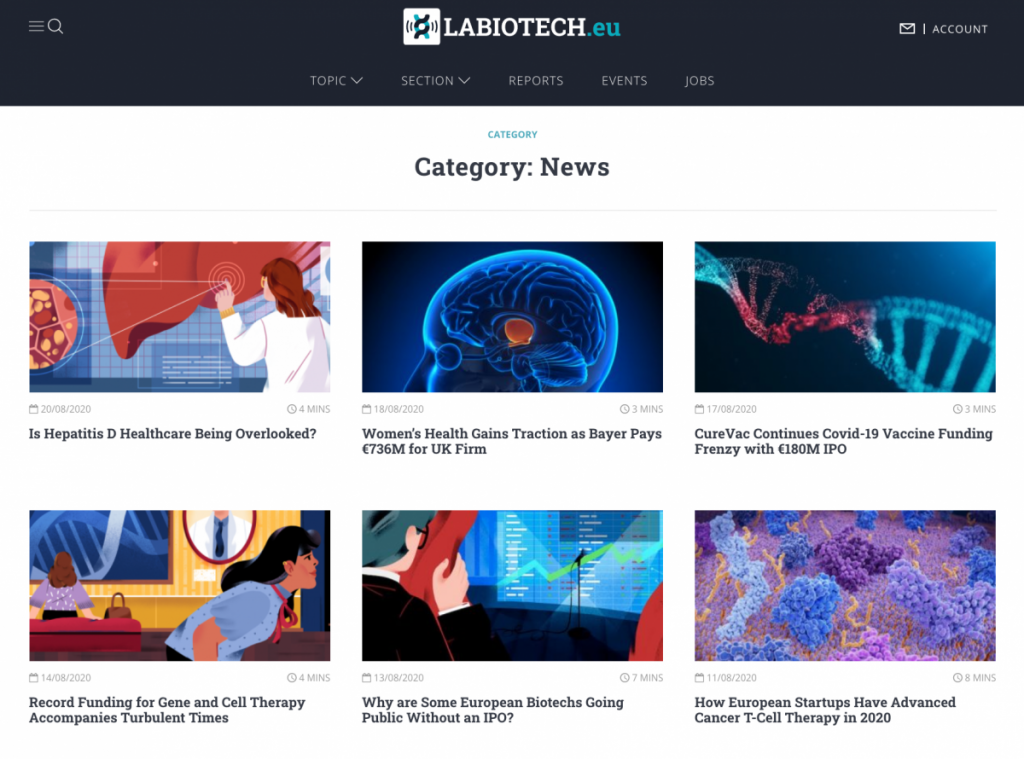
M: why do you think labiotech.Eu has been successful?
J: We have a unique position within the industry thanks to our large biotech-focused audience in Europe. A lot of our advertisers like to combine our channel with US-focused channels to reach a large audience. So we complement what was existing by focusing on an under-served segment of the industry. And for the membership, we’ll see how it goes but we think it will be quite successful.
M: from your own journey, what do you think other vertical publishers could learn?
J: Keeping the focus on what matters and being honest with yourself. Over the years, we’ve tried a lot of strategies, some worked, some not. Sometimes you have to persevere but you also need to recognise when a project is turning into a bad idea. The event business, for example, has been a hard lesson for us and the subsequent projects we decided to launch have been more focused on generating value for the platform instead of venturing offline.
The media industry is a difficult business and keeping a laser-sharp focus can help a lot on the road to success (especially when external funding is so difficult to attract). We have many ideas we’d like to develop but we constantly have to remind ourselves of what’s the most priority and what can benefit the most on the long term. That’s valuable learning for any publisher, especially of small size.
M: which other publishers do you look to for inspiration?
J: When I started the company, Business Insider was a big source of inspiration. Now the recipe they created is spreading and includes us. I’m looking at more specialised publications too: In healthcare, STAT is a great example to follow. Originally spun out from Boston Globe Media, it rapidly acquired a reputation for investigative journalism in healthcare. Their investigation on the origin of the opioid addiction crisis in the US has been featured on HBO’s “Last Week Tonight with John Oliver”. That’s a great example of how a specialised publication can have an impact on the general public and even lead to policy changes.


